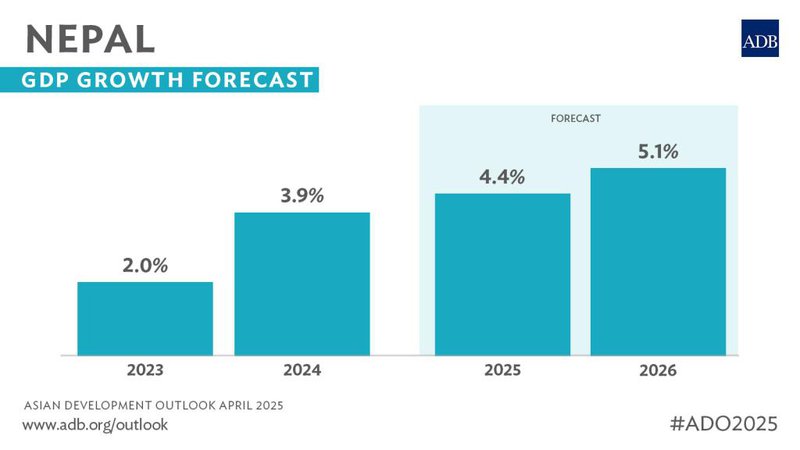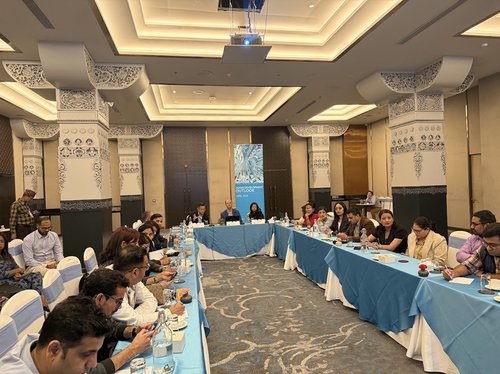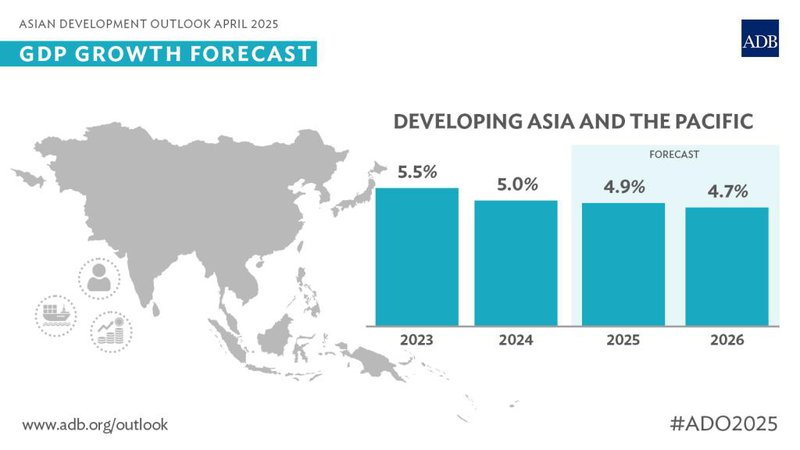

Nepal's economy is expected to strengthen in fiscal year 2025 and continue to improve in 2026. According to the Asian Development Outlook (ADO) April 2025 report from the Asian Development Bank (ADB), Nepal's economy is projected to grow by 4.4% in FY2025, up from an estimated 3.9% growth in FY2024.ADB link
The improved growth forecast for Nepal is attributed to a gradual recovery of domestic demand, ongoing reforms in the private sector, and a boost in tourism and related services. Key economic sectors like manufacturing and construction, which saw a contraction in FY2024, are expected to expand in the current fiscal year.
This growth is supported by stable oil and raw material prices, increased liquidity, and declining interest rates, leading to greater credit availability for all production sectors. ADB Country Director for Nepal, Arnaud Cauchois, highlighted these positive developments in the country's economic outlook.
During the program, Jan Hansen, Principal Economist at ADB Resident Mission Kathmandu, emphasized the key issues outlined in the outlook. He stated that ADB will continue to support Nepal's policies to address climate change.
Hansen also mentioned that the future global economic growth will be significantly influenced by the tariff policies of the US.

Similarly, Manbir Khadka, an economist at ADB Resident Mission in Kathmandu, provided the main highlights of the Nepal Economic Outlook. He noted that economic growth accelerated in FY2024 and is expected to continue to rise this fiscal year and the next, primarily due to the growth in the services sector. Khadka also highlighted that the industry growth, supported by increased electricity generation, is projected to further increase with the upcoming hydroelectric projects.
Khadka emphasized that the geo-political tensions in the middle-east and Gulf regions will have a significant impact on Nepal's economy. He highlighted the region's crucial role in terms of remittances for Nepal.
Gross domestic product (GDP) growth is forecasted to reach 5.1% in FY2026, fueled by government reforms to improve capital budget execution, advancements in tourism and related services, and enhanced agricultural productivity through mechanization and better irrigation systems, contingent on a favorable monsoon. Inflation is expected to moderate in FY2025 and FY2026. The inflation forecast is expected to remain within the central bank’s ceiling, assuming a normal harvest and a modest decline in inflation in India, the major source of imports.
Nepal’s external sector gained stability in FY2024 with higher foreign exchange reserves and a prudent monetary stance. Despite higher imports in the latter half of FY2025, strong remittance inflows are expected to keep the current account surplus at 0.1% of GDP. In FY2026, a deficit equal to 2.4% of GDP is projected as goods and service imports accelerate.

Risks to the outlook tilt to the downside. Ongoing tariff rises may cause a global economic downturn, affecting Nepal’s tourism receipts and remittances, and lower foreign aid could negatively impact growth as Nepal relies on foreign aid to finance development needs. Under-execution of the capital budget would also dent growth prospects.
The growth forecasts were finalized prior to the 2 April announcement of new tariffs by the US administration, so the baseline projections only reflect tariffs that were in place previously. However, ADO April 2025 does feature an analysis of how higher tariffs may affect growth in Asia and the Pacific.
ADB Sees Growth Declining for Asia and the Pacific
Economies in developing Asia and the Pacific are projected to grow 4.9% this year, down from 5.0% last year, according to the latest forecast by the Asian Development Bank (ADB).
Solid domestic demand and strong global appetite for semiconductors driven by the artificial intelligence boom are supporting growth, but tariffs and trade uncertainty will act as a headwind. Regional growth is expected to decline further to 4.7% next year, according to Asian Development Outlook (ADO) April 2025, released today. Inflation is projected to moderate to 2.3% this year and 2.2% next year as global food and energy prices continue to decline.
The growth forecasts were finalized prior to the 2 April announcement of new tariffs by the US administration, so the baseline projections only reflect tariffs that were in place previously. However, ADO April 2025 does feature an analysis of how higher tariffs may affect growth in Asia and the Pacific.
The report notes that while economies in the region are resilient, faster and larger-than-expected changes in US trade and economic policies pose risks to the outlook. Along with higher US tariffs, increased policy uncertainty and retaliatory measures could slow trade, investment, and growth.

“Economies in developing Asia and the Pacific are supported by strong fundamentals, which are underpinning their resilience in this challenging global environment,” said ADB Chief Economist Albert Park. “Rising tariffs, uncertainties about U.S. policy, and the possibility of escalating geopolitical tensions are significant challenges to the outlook. Asian economies should retain their commitment to open trade and investment, which have supported the region’s growth and resilience.”
Further deterioration in the property market of the People’s Republic of China (PRC), the region’s largest economy, could also drag on growth. ADB projects a 4.7% expansion for the PRC this year, and 4.3% next year, compared with 5.0% last year.
Stronger growth in South Asia and Southeast Asia, driven by domestic demand, and a continued recovery in tourism elsewhere in the region will partly offset the slowdown in the PRC. India—South Asia’s largest economy—is projected to grow by 6.7% this year and 6.8% next year. Economies in Southeast Asia are forecast to grow by 4.7% this year and next year.
Weak external demand is expected to weigh on economic activity in Caucasus and Central Asia, with growth projected to slow from 5.7% last year to 5.4% this year and 5.0% next year. For the Pacific, tourism will continue to support growth but at a slower pace, which is forecast at 3.9% this year and 3.6% next year, compared to 4.2% last year.
- Weather Forecast: Generally Cloudy Across The Country Light To Moderate Rain At Many Places of Koshi, Madhesh, Lumbini And Bagmati Province
- Jul 16, 2025
- Nepal’s Largest All-Female Hackathon 2025 Concluded
- Jul 15, 2025
- Nepal Needs a Coordinated Security Mechanism and De-radicalisation Program to Counter Terrorism
- Jul 15, 2025
- FOODMANDU Committed to Make ‘Life Ajhai Better’
- Jul 15, 2025
- Om Vedic Foundation Inaugurates with Grand Ceremony
- Jul 15, 2025














